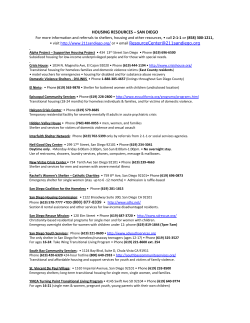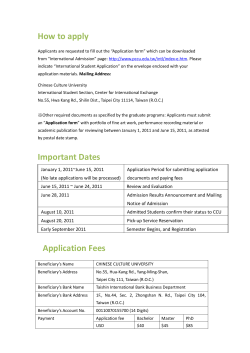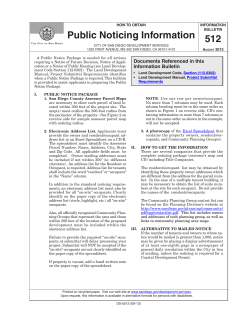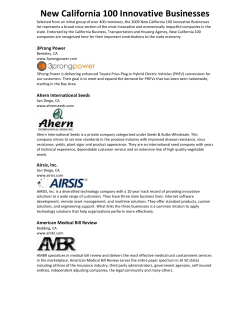
How to fund your trust Spotlight: Asset Management 5A
TUESDAY, DECEMBER 11, 2007 • THE DAILY TRANSCRIPT 5A Spotlight: Asset Management How to fund your trust By MICHAEL B. ABRAMSON Solomon Ward Seidenwurm & Smith LLP Avoiding probate is one of the primary benefits of having a revocable living trust; however, merely setting up a trust is insufficient. In general, the trust must be funded during your lifetime in order to avoid probate. Probate is the process where the court oversees the distribution of the deceased person’s assets in accordance with the person’s will. It is desirable to avoid probate because the probate process can be lengthy (six months or more), costly (executor and legal fees) and an invasion of privacy (probate is a public process). By following a few key steps and working closely with your attorney, your trust should provide your heirs with the assets you intended without the burdens of proAbramson bate. What is “funding” a trust? A trust is “funded” when your assets are transferred to it. An asset can generally be transferred to a trust by changing the asset’s title so it is clear that you are holding the asset as trustee of your trust. The general rule is that assets held in a revocable living trust are not subject to probate. Why is funding the trust important? Your trust likely provides that upon your death (and the death of your spouse, if married), a designated third party (called the “successor trustee”) is given the power to manage and distribute the assets in the trust in accordance with your instructions. If your assets have been funded into the trust, then the successor trustee can proceed to manage and distribute the assets without probate. Who is responsible for funding a trust? The attorney drafting your trust may assist with funding certain assets into a trust, but you are ultimately responsible for ensuring that your trust is properly funded and stays funded throughout your life. Which assets should be funded in a trust? Most clients intend for their trust to serve as a funnel through which all assets should pass. Below are some of the issues relating to funding your trust. • Cash and nonqualified investment accounts Cash accounts (including savings accounts and money market accounts) and nonqualified investment accounts should be funded into the trust. Banks and brokerages are accustomed to transferring their clients’ accounts into revocable living trusts. Sometimes you will be asked for a copy of the trust (though the first page, signature page and trustee powers sections generally suffice). If your bank account or investment account permits you to designate a beneficiary to whom the account should be distributed upon your death, you will likely be able to avoid probate by choosing a beneficiary. However, beneficiary designations should be carefully coordinated with your estate plan. By utilizing a beneficiary designation you will be circumventing your trust — especially where the beneficiaries named in your trust differ from those listed on your account form or if your trust sets forth conditions to the distribution to your beneficiaries (such as a child attaining a certain age). If you hold stock directly in your own name, you should contact the issuer or transfer agent to arrange for the transfer of the stock to your trust. Periodically check your account statements to verify the account remains funded in the trust. • Real property A residence is often the most valuable asset in a person’s estate. Your residence should be funded into your trust. Investment property should also be funded into your trust. This is easily accomplished by filing a deed (with a properly completed Preliminary Change of Ownership form) in the jurisdiction where the property is located. Transfers to a revocable living trust are statutorily exempt from reassessment and transfer tax. A lender is generally prohibited from triggering a due-on-sale provision upon a transfer to a revocable living trust. If you own investment property through an entity, such as an LLC, you should own that entity in your trust. Lenders sometimes ask clients to transfer property out of a revocable living trust while the property is being refinanced. Be sure to transfer it back into the trust upon the completion of the refinance. • Life-insurance Life-insurance ownership and beneficiary designations should be carefully coordinated. As with bank accounts and investment accounts, life insurance payouts will circumvent your trust unless the trust is the beneficiary. Discuss with your attorney whether your revocable living trust should be named the primary beneficiary or a “back up” beneficiary and whether the policy should be owned by the trust or otherwise. • Qualified investment accounts (IRAs and 401(k)s) Use great care (and consult with your accountant, financial planner or lawyer) when adjusting the title or beneficiary designation of your IRA and 401(k). To preserve the favorable tax treatment of these accounts, they should remain titled in your name individually. As with bank accounts and life insur- See Fund on 6A Socially responsible investing offers multitude of investment opportunities By JAN SCHALKWIJK Special to the Daily Transcript Socially Responsible Investing (SRI) incorporates environmental, social and corporate governance evaluation. With increasing awareness about sustainable living, the environmental aspect commands the most attention from the public and the media these days. And for good reason — we are facing tremendous challenges related to climate change and other environmental issues. The green revolution is the latest trend 25 years in the making. In addition to the environmental aspect, investors are also looking at other criteria to evaluate whether a company represents a responsible investment. An ever-growing chorus of institutional investors, such as pension funds and large endowments, is voicing concerns related to gender equality and employeefriendly workplaces. Moreover, retail investors are joining the choir. The marketplace has responded by making available mutual funds that offer SRI screening specifically related to workplace, gender equality and other social issues. Parnassus Investments, an SRI mutual-fund company based in San Francisco, has a product called “The Workplace Fund.” According to the company’s Web site, it “looks for companies that have great workplaces for their employees, with the idea that happier employees make for better companies.” To find these companies, Parnassus Investments works with Milton Moskowitz, the coauthor of Fortune magazine’s “100 Best Companies to Work For.” Parnassus ultimately decides which stocks to hold, using Moskowitz’ work as a guide. The notion that good places to work are also good investments — or at the very least do not pay a performance penalty for treating their employees with respect — appears logical. So far, the fund, which was created in April 2005, has delivered. The year-to-date performance as of Sept. 30 amounted to 10.32 percent, compared to 9.13 percent for the S&P 500 and 9.41 percent for the Lipper Multi-Cap Core Average. PAX World Funds, based in Portsmouth, N.H., has recently assumed ownership and portfolio management responsibility for the Woman’s Equity Fund. According to PAX, the Women’s Equity Fund “applies sustainable investing criteria, emphasizing companies that promote gender equity through internal policies and programs, transparency regarding the effectiveness of those policies and programs, and accountability among employees to assure implementation and observance.” The gender criteria are in addition to the other environmental, social and governance (ESG) criteria that PAX uses in its investment analysis. Although it may be difficult to assess a performance differential based on how a company approaches gender, it certainly is not difficult to ascertain that gender equality is desirable and, in combination with other ESG factors, can lower a company’s risk exposure and increase its attractiveness. It is also important to note that just as the aforementioned funds look at more than workplace and gender issues, other SRI funds may also look at these particular issues as part of their broader screening process. Understanding how a fund screens will help an investor decide whether it passes the investor’s own criteria. An investor can get a good idea of what a fund company may or may not invest in by looking at the company’s ESG criteria, which are often displayed on its Web site or in its prospectus. When it comes to issues such as nuclear power or gambling, different fund companies take different views, or may have varying levels of tolerance. As there are no perfect corporate citizens, it is hard to find a perfect mutual fund, especially for the SRI purists. Keep in mind that even though there may be some fund holdings that operate in the grey area, the fund manager can still exert influence as a shareholder and use shareholder advocacy to promote ESG issues. Consider therefore not just what you own, but also how you own. If concerned investors cannot find enough funds to diversify their portfolio that meet their criteria, it may make sense to supplement funds with individual securities. The advantage would be increased flexibility. It would be more difficult to engage in shareholder advocacy, however, which is easier done when investors pool their interests into a singular entity such as a fund. The SRI universe has evolved and at present it is much easier for an individual investor to engage in SRI. It is no longer just about sin stock avoidance but about a greater set of issues, with options for investors to focus on certain areas of particular concern. The underlying reason for increased choice is the fact that more companies are coming to the conclusion that it makes good business sense to be responsible. It is not about choosing profits to the detriment of responsibility; the two can go hand in hand. Schalkwijk, CFA, is the founder and principal of downtown San Diego-based JPS Global Investments, an investment advisory firm that specializes in sustainable investing. Source Code: 20071211crb 6A TUESDAY, DECEMBER 11, 2007 • THE DAILY TRANSCRIPT Spotlight: Asset Management Your roadmap to business success Pension funds pulling back Guide your growth with a well thought out plan By ANDREA KOROGI Special to the Daily Transcript Would you start out on a long trip to a new destination without a map? Starting a business or moving into a growth mode also requires a road map to help guide success. Developing a business plan is considered to be the most important step to take in starting or expanding a business. For a startup, the business plan serves as a guide by which to determine your objectives, mission, competition, market strategies and your financial projections. Much of this will start out as “blue sky” projections because you will not have actual facts and figures to guide you. This is where you should spend time researching existing businesses and learning all you can about their products, service and pricing. To do this, just start calling, visiting and talking to people as much as possible. One of the most common mistakes in starting or growing a business is not understanding your personal strengths and weaknesses. If you are excellent at what you do, but hate to sell, you have much less chance at success. All businesses have to sell, and if that is not your strength, then find a partner who is strong in that area, or plan to add more financing to hire a salesperson or produce a great marketing plan. Getting started on your business plan can seem daunting, but you do not need to completely reinvent the wheel. There are hundreds of great sample business plans from A to Z online, and there is no reason you cannot use some of that wording and those strategies to develop your plan. If seeking financing, you will need to show that you know your industry and the competition very well. One resource to use for determining the income and profit of specific companies is a guide called the RMA Annual Statement Studies. Banks use this guide to help determine performance standards for businesses, and you can find it at local libraries. All businesses, whether startup or growing, will be required to supply prospective financing data. In most cases, creditors will want to see what you expect your company to be able to do within the next five years. Make sure your projections match your funding request and include a short analysis of your financial information. Financial institutions are not necessarily looking for a lengthy business plan, but one that tells your story well through research, strategy and financial projections. If you get stuck on the financial projections, you can go online to get programs such as Cash Compass, go to a local organization such as the Carlsbad Chamber of Commerce for established business counseling, or SCORE for startup counseling. Existing companies need an updated strategic plan every one to two years. How long has it been since you have taken the time to update your strategy, focus on your main priorities, evaluate your pricing or realign your team for best performance? As an owner of a small or medium business you cannot afford not to plan, otherwise outside influences will determine your direction. Whether you call it a strategic, operational or business plan, every business owner needs to take the time to chart their course. This is a great opportunity to sit down with your team, part- ner, accountant or just yourself and evaluate where you are and where you want to go. Small business owners have three basic types of assets: human (or more aptly, time), financial (including inventory) and tangible (fixed assets). “Allocating human or time resources should be the highest priority, as usually these are the scarcest resource and these are also the assets that will give the most bang for the buck. Ask yourself, ‘Where will I allocate our time this year — marketing and prospecting, sales, profit improvement, training or organizational areas?’ Financial assets should be allocated based on the premise of filling the current capacity or expanding the current capacity,” said Kris Sinderholm, owner of SBS Associates. “Again, ask yourself, ‘Which is more important to our business this year, filling the pipeline or expanding the pipeline capacity?’ Tangible assets will generally follow the first two.” Organizations like California Manufacturing Technology Consultants (CMTC) and Small Manufacturer’s Advantage offer a SWOT (Strength, Weakness, Opportunities & Threats) analysis at no charge to help small business owners evaluate where they should put their emphasis. “It’s really helpful to have a professional look at your business with an objective lens and provide an improvement plan that can often lead to increased productivity and higher profits,” said Lorri Aiello, manager of CMTC. Marketing is one of the most important areas of your strategic business plan. The process of creating customers and keeping customers loyal should be the lifeblood of your business. There is no single way to approach a marketing strategy because each company is unique. As your business grows, your marketing strategy should change to reflect what has worked well and less effective programs should be eliminated. As an example, if a customer loyalty program that includes a discount for return customers is producing results, but the advertising flyer you have been distributing has not been producing results, look at allocating more funds toward your loyalty program. Make sure you have a way of tracking the effectiveness of your programs, and compare them from year to year. If you still find it difficult to evaluate your business and write the plan on your own, seek outside resources. As a planning tool, these strategies should guide you through the various phases of your business. To make it even more effective, share the plan with employees to foster a broader understanding of where the business is going. Korogi is director of Small Business Development for the Carlsbad Chamber of Commerce. Source Code: 20071211crc By CRAIG KARMIN The Wall Street Journal As the U.S. stock market struggles, it is facing another head wind: Some of the nation’s most powerful investors are unloading shares in a big way. Several of the largest public pension funds have been selling billions of dollars held in U.S. stocks, and others are expected to join in. In most cases these actions are unrelated to the recent market jitters, though worries about the economy, the weakening dollar and the credit crisis could be accelerating these moves. More broadly, they are part of a long-term plan to reduce stock holdings in U.S. companies to help fund other investments. Among the funds that are part of this trend: the New York State Teachers’ Retirement System, the New York State Common Retirement Fund, the Teacher Retirement System of Texas and the Florida Retirement System Pension Plan. Collectively, these plans control more than $500 billion in assets. Recently, the nation’s largest public pension fund indicated that it may soon join them. Russell Read, chief investment officer for the California Public Employees’ Retirement System, or Calpers, said at a board meeting last week that the $250 billion fund could enhance returns by moving assets to foreign from U.S. stocks. One plan calls for Calpers to reduce its U.S. stock position to 24 percent, from 40 percent of its portfolio, which would represent the fund’s lowest allocation to U.S. stocks in more than 20 years. Calpers’ board will consider the measure next month. While some public pension funds are bucking the trend by keeping their U.S. stock holdings steady, industry consultants said the clear majority — many still wary of the stock market selloff at the start of this decade — are cutting back. “This is a long-term systemic trend,” said Cynthia Steer, chief research strategist at Rogerscasey , a Darien, Conn., consulting firm. “It isn’t going to turn around soon.” Source Code: 20071211crd Fund Continued from Page 1A ance (discussed above), using a beneficiary designation will circumvent your trust. Generally, you should either list your trust as the beneficiary, or list your surviving spouse as the primary beneficiary and the trust as the “back up.” • Closely held business Shares of closely held corporations, membership units of limited liability companies and partnership interests should be held in your trust. Transferring ownership in a closely held business to your trust is accomplished by transferring your certificates (or other evidence of ownership) to the trust. You may also want to execute a stock power or transfer separate from certificate. Be sure this transfer is properly reflected in the company’s books and records. Pay careful attention to how this transfer may affect any shareholders agreement, operating agreement or partnership agreement, and confirm the transfer is not prohibited by or inconsistent with the terms of such agreements. • Vehicles Most clients choose not to place their vehicles in their trusts because vehicles are frequently changed and the DMV has a procedure to facilitate the transfer of a vehicle without probate after the owner’s death. If you desire to place your vehicle in your trust, the DMV can assist you with the transfer. Abramson is an attorney with the San Diego law firm Solomon Ward Seidenwurm & Smith LLP and routinely advises clients on business, real estate and estate planning matters. Source Code: 20071211cra Money Management Firms Listed by Minimum Investment Amount (Institution) Name Address Phone, Fax E-mail URL Minimum Investment (Institution) Minimum Investment (Individual) Total Assets Managed Number of Portfolio Managers 1 Brandes Investment Partners LP 11988 El Camino Real, Suite 500 San Diego CA 92130 (858) 755-0239, (858) 755-0916 clientservice@brandes.com www.brandes.com $10,000,000 $100,000 $121,700,000,000 41 Selected U.S. and non-U.S. equity and fixed income portfolios Charles Brandes, Chairman; Glenn Carlson, CEO 1974 2 Chandler Asset Management 9255 Towne Centre Drive, Suite 350 San Diego CA 92121 (858) 546-3737, (800) 317-4747, (858) 546-3741 info@chandlerasset.com www.chandlerasset.com $10,000,000 $500,000 $3,000,000,000 3 Provides fully customizable, client-centered portfolio management that preserves principal, manages risk and generates income Kay Chandler, CFA, President/CEO; Martin Cassell, CFA, Exec. VP/Chief Investment Officer 1988 3 GlobeFlex Capital LP 4365 Executive Drive, Suite 720 San Diego CA 92121 (858) 658-9060, (858) 658-9061 info@globeflex.com www.globeflex.com $10,000,000 n/a $4,300,000,000 5 U.S. Small Cap equity, U.S. Small Cap Growth equity, U.S. Mid Cap equity, International All Cap equity, International Small Cap Equity Marina Marrelli, CEO; Robert Anslow, CIO 1994 4 LM Capital Group LLC 401 B St., Suite 920 San Diego CA 92101 (619) 814-1401, (619) 814-1404 smartinez@lmcapital.com www.lmcapital.com $10,000,000 n/a $2,011,000,000 3 Opportunistic core, fixed income-core, fixed income, intermediate fixed income, short-term fixed income portfolios Luis Maizel, Senior Managing Director; John Chalker, Managing Director; Richard Deary, Sr. VP Marketing and Client Services 1989 5 Duncan-Hurst Capital Management LP 4365 Executive Drive, Suite 1520 San Diego CA 92121 (858) 597-4800, (858) 597-4802 dhcm@dhcm.com www.dhcm.com $5,000,000 $25,000 n/a 6 Growth equity portfolio management in all market capitalization ranges William Duncan Jr., Chairman/CEO; Frank P. Hurst, President; Michael De Mayo, CFO; Rebecca LaFerney, VP, Admin. 1990 6 Northern Trust Bank of California 4370 La Jolla Village Drive San Diego CA 92122 (858) 824-1200, (858) 457-2876 www.northerntrust.com $5,000,000 $2,000,000, fully managed account, $2,500, mutual funds $653,000,000,000 3 (local), 99 (companywide) 7 Rice Hall James and Associates LLC 600 W. Broadway, Suite 1000 San Diego CA 92101-3383 (619) 239-9005, (619) 239-6034 info@ricehall.com www.rhjfunds.com $5,000,000 $2,000,000 $2,414,100,546 (as of March 06) 8 Small Mid Cap equity, Mid Cap equity, Micro Cap equity separate accounts and mutual funds Thomas W. McDowell, CEO/Portfolio Manager/Analyst; Kevin T. Hamilton, CFA, President/Portfolio Manager/Analyst 1974 8 Caywood-Scholl Capital Management 4350 Executive Drive San Diego CA 92121 (858) 452-3811, (858) 535-9068 info@rcm.com www.caywood-scholl.com $3,000,000 $3,000,000 n/a 3 High-yield fixed income and investment-grade fixed income James R. Caywood, Principal/Chairman Emeritus; Eric Schol, Chairman/CEO/Co-CIO; Thomas Saake, President/Co-CIO 1986 9 Messner and Smith Investment Management Ltd. 530 B St., Suite 300 San Diego CA 92101 (619) 239-9049, (619) 239-0838 info@messnerandsmith.com www.messnerandsmith.com $2,000,000 $1,000,000 $292,000,000 3 Separate account strategies, midcap value, SMID value, small cap value, balanced, limited partnership strategies, midcap value, small cap value, balanced John Messner, Principal/Portfolio Manager; Ellis Smith, Principal/Portfolio Manager 1984 Financial Products Offered Executive(s) & Title(s) Portfolio management, private banking, brokerage services, financial conSherry Barrat, Chairman/CEO/Director, Northern sulting, wealth management, securities custody, separately managed Trust Bank of California; Susan Mallory, Regional accounts, estate planning, wealth advisory services, alternative investPresident, San Diego ments, mutual funds and trust administration Year Established 1889 Data Source: The Companies and their Web sites. Listed by Minimum Investment (Institution). This is a partial list. A more complete listing can be found at sourcebook.sddt.com. N/A: Not Applicable, n/a: not available, wnd: would not disclose. It is not the intent of this list to endorse its participants, nor to imply that the company’s size or numerical rank indicates its quality or service. We reserve the right to edit listings or to exclude a listing due to insufficient information. The following companies did not respond to our survey: La Jolla Asset Management, American Investment Bankers, Merrill Lynch. Compiled by Robin Scott, robin.scott@sddt.com. Last updated 11/2007.
© Copyright 2025









